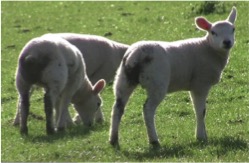Unseasonably high winter temperatures across most parts of the country could impact on parasite infectivity at turnout for both sheep and cattle, according to NADIS in its March parasite forecast. Merial Animal Health, sponsor of the forecast, recommends that farmers plan their parasite control now for this year’s grazing season, to reduce production loss.
In sheep, this winter’s higher than average temperatures indicate a moderate to high risk of chronic liver fluke disease in parts of the UK. Scotland, North Wales and North West England are predicted to experience the highest incidences of disease.
“Treating ewes to remove patent, egg-shedding liver fluke infections will help to reduce subsequent fluke challenge to growing lambs later in the year,” advises Merial’s veterinary advisor Sioned Timothy.
“As chronic fluke disease is caused by the adult stage of the liver fluke it is not necessary to use a triclabendazole-based product that targets all stages of the parasite at this time of year. Alternative flukicides that target the more mature life stages of the parasite such as, nitroxynil (Trodax), closantel, albendazole or oxyclozanide may be more appropriate at this time of year. Once treated, sheep should be moved to clean pastures.”
The principle aim of parasite control at lambing is to minimise pasture contamination with eggs passed from adult parasites. The likelihood of lambs and ewes becoming infected when grazing can be determined by the previous use of pastures.
Maximising the use of safe grazing (i.e. pastures that have not been grazed by sheep in the last year, or re-seeded pastures) at turnout will help avoid the risk of nematodirosis and parasitic gastroenteritis (PGE) in lambs later in the season. If safe grazing is not available for the whole flock it should be reserved for higher-risk ewes and those rearing multiple lambs.
Dosing ewes around lambing time can help reduce the peri-parturient rise in faecal egg production during the grazing season, which can cause PGE and production loss in lambs later in the year. However, any decision to treat ewes during or after lambing must take wormer effectiveness, and the timing and frequency of dosing into consideration, to avoid increasing anthelmintic resistance.
SCOPS advises adopting a compromise between reducing pasture contamination and achieving full parasite control by targeting youngstock, ewes rearing multiple lambs, and ewes in a low body condition, leaving around 10% of the overall flock untreated. This approach will protect overall production and reduce overall egg output onto pastures, while preventing selection for anthelmintic resistance.
Nematodirosis can cause considerable production loss at turnout. Cold weather delays the hatching of the Nematodirus battus eggs on pasture, but sudden increases in temperature can trigger a mass hatch. If hatching coincides with lambs taking in significant quantities of grass, infection rates and resulting disease can be high.
From March onwards both NADIS and SCOPS provide Nematodirus forecasts that alert farmers to the risk of egg hatching in their local area. Using these resources alongside a strategic plan for safe-grazing and targeted treatments can lessen the impact from nematodirosis. It is important to reduce pasture contamination wherever possible, to reduce the risk of infection in the following season.
Coccidiosis may also occur in young lambs and can present with similar clinical signs to nematodirosis. Stress is a major factor in triggering outbreaks, but adverse weather conditions, poor colostrum supply, wet, muddy paddocks previously grazed by sheep, and/or extended housing periods may also predispose lambs to infection. A vet should be consulted if differentiation between nematodirosis and coccidiosis is required.
Cattle farmers are urged to plan their parasite control for the year and decide on a strategic or targeted approach. Strategic parasite control plans use timed dosing and grazing management techniques, whereas targeted approaches monitor animals regularly and treat when necessary.
COWS recommends considering the production objective for the types of cattle present, the farm infrastructure (particularly in relation to pastures, grazing management and handling facilities) and the presence of existing parasites when planning a control strategy for the season.
Housed youngstock, which were not dosed for worms in the autumn, may be at risk from type 2I ostertagiosis caused by inhibited (L4) gutworm larvae towards the end of the housing period. Animals assessed as being at risk should be treated with a product that removes L4 stage Ostertagia ostertagi.
“After turnout, young cattle rapidly become infected from overwintered larvae on the pasture,” says Ms Timothy. “Strategically treating youngstock at grass can help prevent parasite burdens from increasing and avoid high levels of pasture contamination later in the grazing season. This lessens the risk of parasitic disease and can protect growth rates and overall production.
“Cattle can be treated with an appropriate pour-on or injectable wormer such as those containing ivomectin (Ivomec). Cattle treated strategically should remain set-stocked, or moved to safe pastures when these become available.”
If a targeted approach to gutworm control is taken, animals should be monitored; regular weighing can identify animals suffering from parasite associated growth checks, and pooled faecal egg counts will provide an indication of the groups’ parasite levels. Parasite control will be determined by the identification of worm eggs, and/or by checks in growth rates. Targeted treatments must be timed appropriately in order to be effective.
“I would encourage cattle farmers to plan their lungworm prevention strategy now, especially where there is previous history of the disease on farm,” urges Ms Timothy. “Vaccination of calves over two months-old requires two doses of the lungworm vaccine four weeks apart with a second dose at least two weeks before turnout, so time is of the essence.”
Outwintered beef cattle may be at particular risk of liver fluke disease if they have been grazing potentially infected pastures. Farmers are encouraged to discuss positive slaughterhouse results with their veterinary advisor and consider treating if appropriate.


